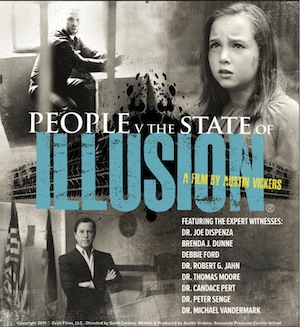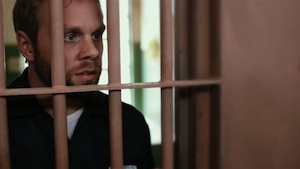 “The significant issues we face cannot be resolved at the same level of thinking we were at when we created them.”
“The significant issues we face cannot be resolved at the same level of thinking we were at when we created them.”
This quote from Albert Einstein begins the new film, People vs the State of Illusion.
We face challenges everyday but how do we see a way out when we feel trapped? What happens when our present situation isn’t serving us, no matter what we do? What is the solution when we can’t seem to manifest what we really want? Do we give up or get out of a situation that is causing us suffering?
Perhaps there is another way of thinking that can bring about change in our lives.
This is the radical and innovate idea explored in People vs. the State of Illusion. In this film, former attorney, and current coach, Yoga teacher, and filmmaker Austin Vickers sets up what he calls the most important trial we could ever witness—a trial that cross-examines our perceptions, our state of illusion.
Austin claims that we become stuck in patterns of thoughts and beliefs which create prisons around us. In People vs State these prison walls are a metaphor used to lead viewers on a journey through the eyes of someone who not only feels trapped in his life, but has become literally imprisoned. We follow the main character, single father Aaron Roberts, as he is coping with crippling stress. In a moment, his life changes when he is involved in a car accident, driving after a few glasses of wine. The other driver was killed, Aaron is incarcerated, and his daughter becomes a ward of the state. Aaron’s subsequent time behind bars causes him to re-evaluate his imprisonment and find a new way of perceiving his world. While his prison walls may be real, they reflect the virtual walls we experience in our own lives.
As proposed in the film, once we realize the “prison walls” in our minds are created by our imagination, we can incorporate that same imagination to release ourselves from painful illusions and end our suffering. It took imagination for us to arrive where we are now, so Austin encourages us to redirect our imagination to release ourselves from situations that appear to be not working.
Accompanied by a host of expert witnesses including Joe Dispensa, Debbie Ford, Thomas Moore, Dr. Peter Senge, Dr. Candace Pert, and Dr. Michael Vandermark, Austin sets out to convince us that shifting our perceptions allows us to change our lives. As Dr. Vandermark states, “We create our own prison walls by our biases and beliefs.”
Finding freedom involves what Austin identifies as the Content to Process Shift.

Some of the impetus for exploring this journey came from Austin’s personal experiences with depression. At first it frightened him. He would turn inward and spend time at home writing rather than socializing. Then he realized the value of his depression: it would allow him to cultivate creativity. Changing this perception allowed him to accept his feelings, and in doing so he stopped experiencing the lowest lows of depression. Whenever he felt the feelings coming on, on he would accept it and focus on the creative value of the feelings and they would dissipate.
One of the ideas expressed in the film is, “The only reality that exists is the reality we choose to participate in.” Austin explains, “We are imagining everything, either consciously or unconsciously.” We cannot possibly process all of the information of reality surrounding us. Austin says, “We are capable of consciously processing less than one one-thousanth of one percent of the information we have access to; so what we experience in the world is not reality, but a view of ourselves that for most people is largely unconscious, because we react to life so habitually. Once we realize we are imagining almost everything, we can begin to be conscious of that imagination and find imaginations that serve us and others. That is when the magic in life begins.”
What happens to our protagonist Aaron behind bars? How does he engage in the Content to Process Shift? What are the final decisions by judge and jury? In order to answer these questions, see the film. It just may stimulate you to see your own life differently.
People vs the State of Illusion is being released by Samuel Goldwyn Films in theaters across the US. Sign up for the latest news at: thestateofillusion.com.
Suzanne Bryant is a writer, health coach, Yoga teacher and filmmaker, whose film Yoga Is, explores her own journey to find a way out of suffering through the practice of Yoga. Yogais.com.
